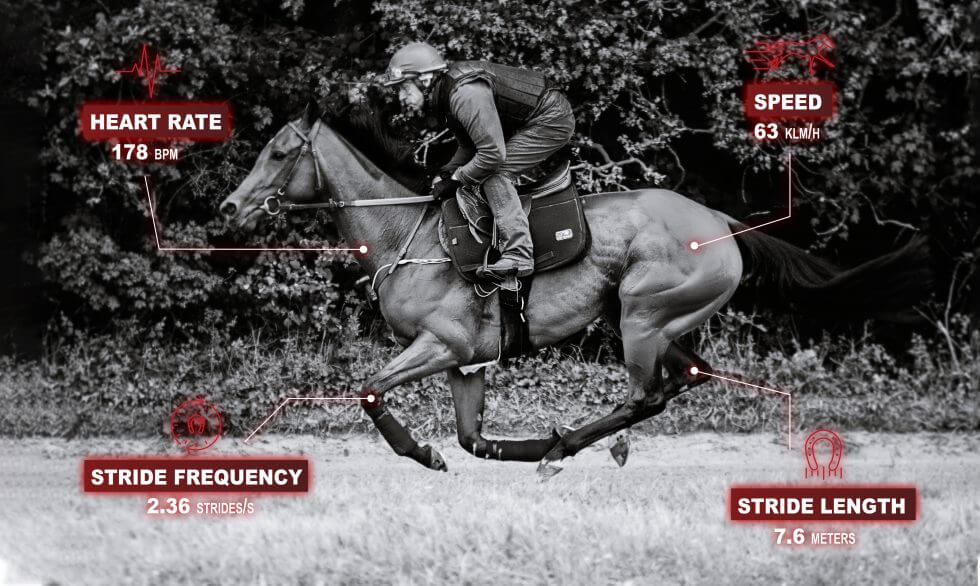1. Preferred distance and locomotor profile
Stride frequency and stride length influence the fatigue felt by the horse. It is therefore possible to decide on which races to enter a horse by studying his locomotor profile.
How does locomotion influence engagement strategies? How can the preferred distance of a horse be identified by his locomotor profile? What strategies should be adopted during the finish?
Stride length and stride frequency do not use the same energy production process. On the first hand, as stride frequency allows sudden accelerations, it cannot be sustained for long as it depends on the cardio-respiratory system. On the other hand, reaching the maximum stride length requires a longer period of time and a strong musculature. Once reached the stride length, maintaining a wide stride is easier than maintaining a high stride frequency. Analysing the locomotor profile maximises the horse’s chances of success.
When entering a horse in a race, a difference must be made between the locomotion at the race speed (for example the stride length & stride frequency at 60 km/h), and the maximal speed locomotion monitored during training. The former will influence the choice of entry when choosing the distance, when the latter will influence the acceleration strategy during the race and during the finish.
It is advised to be aware of the targeted race pace (deducting the times of the first 200m and the last 600m). In most cases, it is around 65km/h in a flat race and around 1min12s per kilometre in trot races, those speed varying with the race distance. The next step is to identify the stride length and stride frequency of the horse at this specific speed.
If the stride frequency is too high in relation to the distance of the race (too long), the horse may get tired very quickly and will not have the necessary capacity to hold the acceleration for long. Otherwise, if the stride frequency is too low for the distance of the race (too short), the horse’s speed will not allow him to keep up with the variations in pace of his opponents.
2. Race strategy and locomotion management
In order to develop a winning race strategy, knowledge of the maximal stride frequency and stride length provides valuable insights.
First of all, it is important to know the horse’s stride length and stride frequency at his maximum speed. By comparing these values with the average values during the finish of the targeted race, it is possible to find out whether the horse has a better stride length or a better stride frequency than the other competitors. Horses with a better stride frequency can wait until the last moment to start the sprint because they will reach their maximum speed very quickly. Horses with a wide stride length will have to be thrown earlier to reach their maximum speed. These values must however be weighted by the difference between the maximal locomotion and the locomotion parameters at racing speed (60 km/h). If the difference between maximal stride length and race speed (e.g. 60km/h) stride length is high, it makes sense to increase the sprint distance. Otherwise it can be shortened.
Example
Let’s take an example of two horses with completely different locomotor profiles, ARION I and ARION II.
When comparing the at-60 km/h values of ARION I and ARION II with the race averages, it appears that ARION I has a very high stride frequency which should give him an advantage in very short races of around 1200m. On the other hand, ARION II has a very low stride frequency which he balances with a wide stride length. Longer races should give him an advantage.
Once the distance has been chosen, the finishing strategy will be different. ARION I has a maximum stride length very close to his racing speed stride length (less than 20cm apart). He can wait before launching the sprint and keep the large stride until increasing his stride frequency. For ARION II, his maximum stride length is higher than his racing stride length, hence the advantage of launching the sprint from a distance to allow him to reach his stride length.


Depending on the effort required, the horse preferably increases his stride frequency or stride length. Studying the locomotion parameters of a horse at the racetrack can be a precious help in choosing the distances of the race.
Keywords: locomotor profile, distance choice, race strategy, stride frequency, stride length

